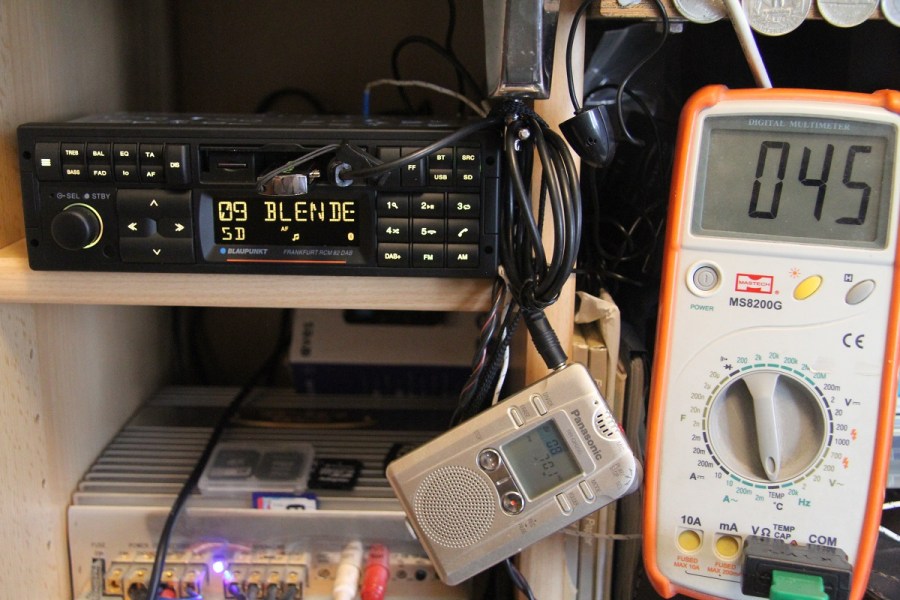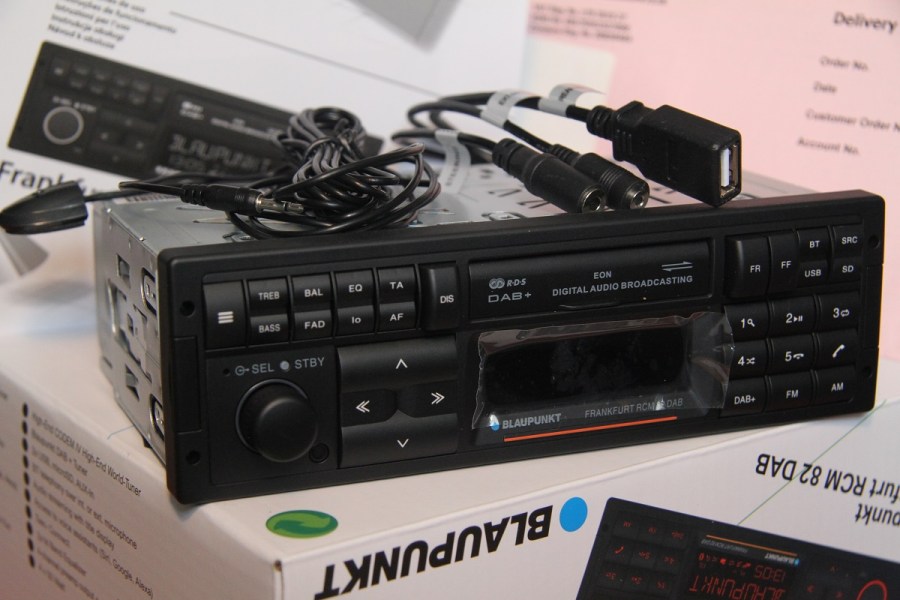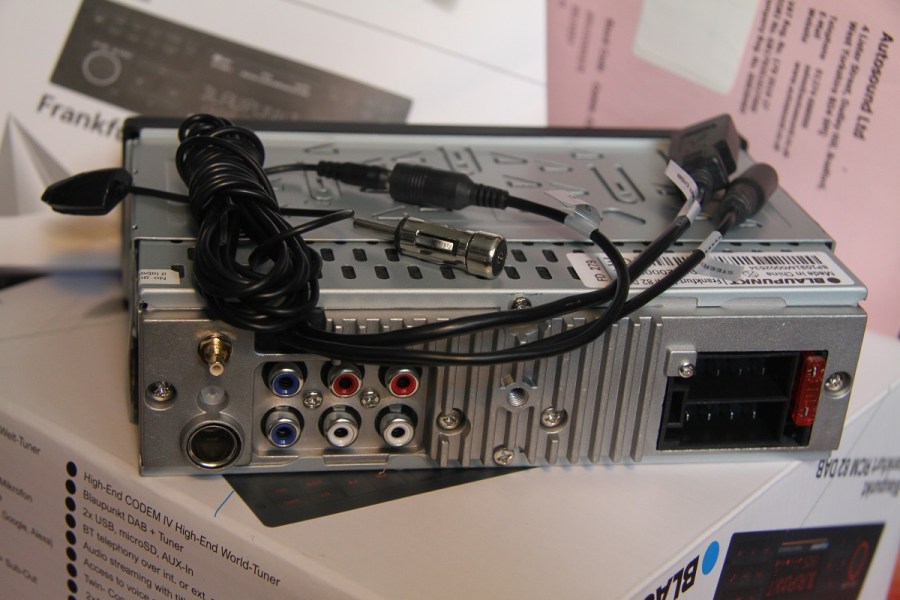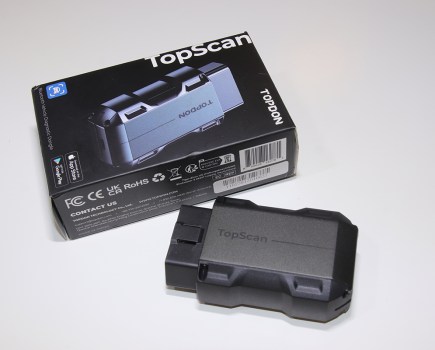RRP: £479.99. Buy it here. $514.90. Buy it here.
Before we dive into this Blaupunkt Frankfurt RCM82 review, it’s worth considering where it sits in the grand scheme of the car audio world. See, design culture varies around the globe. And that applies to electronics, too. Big companies will supply different products to different territories. There are also differences between markets’ appreciation of audio. In the UK, we love it to be ‘HiFi’. Rich and detailed but not too aggressive. In Germany, fancy speakers sound a lot more clinical and less warm. For car audio to send to Africa, they prefer multiple piezo-electric tweeters that can raise Cain. For the USA, the Japanese provided bigger, badder, more costly versions than would easily sell in Europe. They even had names for their top end JDM stuff that we never had in Blighty. How about Carrozzeria for Pioneer and Addzest for Clarion?
And the love of Retro products, design and toys has never been stronger. You can get an old car converted into an EV. You can get an ancient original radio fitted with a Bluetooth chip! And now, there are car radios made just for use in ‘retro’ cars. The RetroSound brand springs to mind here (they make a modular system that has wide applicability), and now there’s this from Blaupunkt too.
Old on the outside, new on the inside
From the look of the box onwards, the new Blaupunkt Frankfurt RCM82 is entirely designed to be retro. Well, at least in terms of its appearance. While it is retro in looks, it is bang up to date with technology. The Frankfurt RCM82 has astonishing quality and processing power, but looks like a cassette deck from the 90’s. However, the flap opens up to reveal a MicroSD slot, a USB slot and an AUX socket. There’s another USB socket on a wire hanging out the back, too. It has a DAB/DAB+ radio as well as Blaupunkt’s legendary CODEM IV FM tuner. That can be set for broadcast bands/frequencies in the EU, USA, South America and Thailand.
On paper, that all sounds great. So let’s see what it’s like in practice…
We check 1,000s of prices on 1,000s of retailers to get you the lowest new price we can find. Fastcar may get a commission from these offers. Read more here.
Setup and operation
The LCD display’s lighting has ‘Variocolour’ RGB backlighting that can be adjusted by sixteen steps for each LED. This gives 4,096 colors to match your dash lighting in say, your BMW. I love to leave these systems scrolling for variation in the photography.
There were some issues getting the testing under way. I wanted to check out every input of course. I have a selection of flash drives on USB but only one old 32GB MicroSD with full size adapter. It was used for my Samsung Galaxy phone. I popped it in the adapter and plugged it into the card reader connected to my computer. I highlighted all the files on it (after backing them to my 8TB drive-in-a-bucket) and then binned them. Then, I slapped a heap of tunes onto the MicroSD, intentionally in a higgledy-piggledy fashion. I then plugged in everything including the new thermocouple, and tried it all.
The MicroSD card behaved strangely. The processors in car radios, that read root and files of directories of tunes on storage, all vary in capability. Every unit, including this one, has disclaimers and say if yours doesn’t work try a different medium/version. But as I had failed to format the MicroSD, all the ‘deleted’ files were still on there! The machine wanted to play them all! That included scrolling the titles of image folders before being shown the .jpg file numbers. It played the sound track to video files. The device doesn’t even have a video output!
I played WMA, M4A, mp3, FLAC16 & FLAC32 files. And they all sounded crisp and clean. I reckon the Peter Gabriel Live In Athens recording is the best-sounding in FLAC32. But I had problems with the Auxiliary input.
Aux troubles
I know a bit about the 3.5mm jack plug. Tip-sleeve configuration is earpieces, mono. Tip-ring-sleeve is stereo and tip-ring-ring-sleeve is stereo with a control circuit like volume and connect/disconnect. There are ones with yet another ring that are usually moulded to red/white/yellow RCA plugs for audio-visual use. But this socket is stereo. It transpired that the expensive cable from the £300 Parrot headphones I was using, was too short of plug. It could not reach inside to the magic switching spot that turned on the Aux input!
I tried another jack to jack and it worked, playing twenty-five year old recordings of my son as a toddler, singing nursery rhymes. They too, were clean and crisp. Just old digitally low resolution recordings, faithfully rendered. Two more 3.5mm jack sockets hang out the back on cables. One is for a steering wheel remote control function, the other for the included microphone. Even though a long-cable mic’s provided for this socket, there’s also another microphone built into the face of the unit.
On the subject of old tech, the Frankfurt also sports a standby flashing LED that looks like an ‘alarm’ function. Scary red flashy light!
Remote control
There is a full IR remote control system on board and the 18-button remote control is shown in the manual. The Frankfurt RCM82 is in fact compatible with the last five models of Blaupunkt car remotes, being the RC-08/09/10/10H and 12H. But it is not included, which is a shame, when they include one in the ten-dollar car radio I tried!

How well does it work?
The Blaupunkt Frankfurt RCM82 is a bit of a black swan swimming on the river. Seemingly serene but paddling with power underneath. The functions and capabilities of the Frankfurt are astonishing. You do get a good few buttons but the MENU button is the thing. Once you have got a grip of how to bop it and use the adjustment keys, you are away.
The FM RDS functions are top end, with regional setting as well as the usual programme type and information settings. You get an FM ‘high cut’ filter in three levels. This helps weak or distorted FM signals. Great for pirate radio stations! You can also set it for weak or high sensitivity.
The usual bass/treble/balance/fader controls are backed up with powerful equalizers. They are 14-band from 32Hz to 16kHz and you can adjust their Q factor. This is a measure of how wide the frequencies above and below their headline one, are affected. Is it spiky or a wide dome of lift? (1, 1.41 & 2) You get two – front and ear equalizers. The Rock/Pop/Classic EQ pre-settings are disabled if you use the pukka equalizers. There are digital crossovers, too. Their choice of seven frequencies are; 50Hz, 63Hz, 80Hz, 100Hz, 125Hz, 160Hz and 200Hz. With a six or twelve decibel slope, they are settable as HPF or LPF on front and rear. That’s Low Pass and High Pass, meaning they allow those frequencies through, but ‘traffic cop’ those above (or below) that frequency.
The deep cunning extends to a settable switch-on delay for the amp trigger voltage wire to avoid turn-on thumps. Up to 2.5 seconds. You pick day and night brightness levels for your display then choose auto or manual setting. The included remote microphone sounds great, too.
Absolutely ‘Spitzenclasse!” JA!
Tech specs:
- Single DIN short body mech-free DAB+/FM/AM radio with world-wide settable band reception
- 2xUSB/Aux/MicroSD/twin-connect Bluetooth, with iPod/iPhone control on both USBs.
- Onboard Power: 4x50W @4ohms; Front, Rear, Subwoofer RCA outputs, wired steering wheel control port
- Fr & Rr 14-Band EQ, plus ‘Rock’, Pop’ & ‘Classic”; Subwoofer output adjustable for Gain, Hz and slope
- Internal electronic crossovers: 50, 63, 80, 100, 125, 160 or 200Hz, front and rear HPF/LPF @ 6/12dB
- Remote-ready (not included), security LED, and auto antenna switching output
Looking for something a bit different? Have a read of our Single-DIN car stereo group test.









